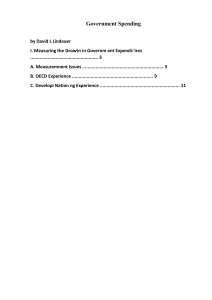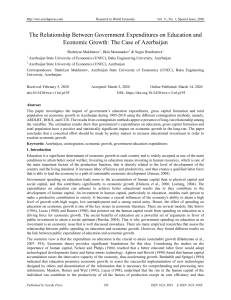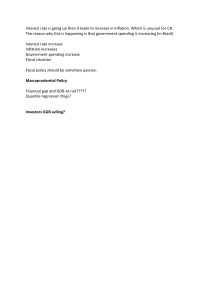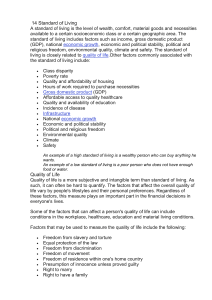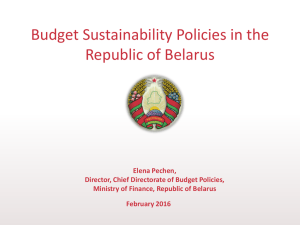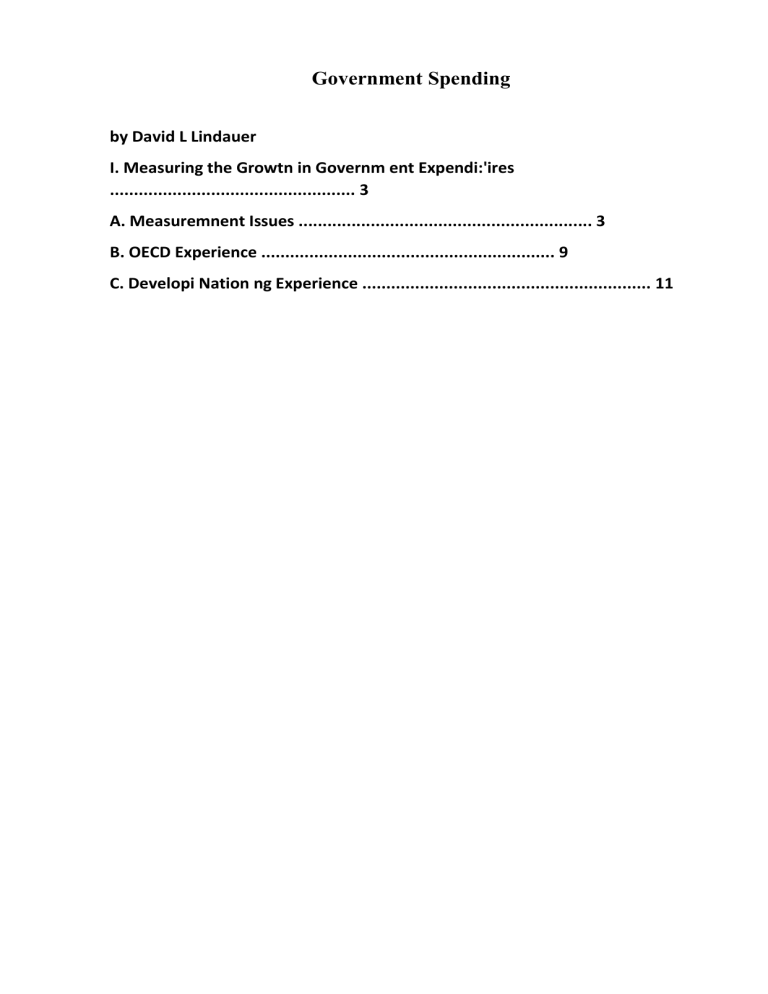
Government Spending by David L Lindauer I. Measuring the Growtn in Governm ent Expendi:'ires ................................................... 3 A. Measuremnent Issues ............................................................. 3 B. OECD Experience ............................................................. 9 C. Developi Nation ng Experience ............................................................ 11 Of the many distinguishing features of economies in the twentieth century, one pronounced trend has been for governments to spend ever larger proportions of national income. This result appears to hold across most countries regardless of the level of economic development. But what begins as a simple empirical observation about the growth of government, quickly gives rise to a wealth of controversies which range from technical debates over measurement and definition, to ideological disputes over the essential role of government in an economy. In this paper an attempt is made to discuss two basic issues concerning the growth of government especially as it pertains to developing economies: (1) what have been the trends in the growth of government expenditures in developing relative to industrialized nations; and, (2) what are the potential explanations for the observed growth in spending by developing country governments. The paper is organized as follows. Section I surveys the empirical evidence on the growth of government expenditures. First, a number of measurement issues are raised, including the definition of the public sector, the appearance of off-budget expenditures, 3 anfl the use of price deflators for government output. Section I then reviews available data on government expenditures for OECD and developing nations. Both a long term perspective, provided by several OECD economies, and contemporary experience, essentially since 1960, are presented. In Section II, the determinants of the growth in government are mconsidered. This literature covers demographic demands for expenditure growth, the changing relative prices of public vis-a-vis private goods, the income elasticity of public goods, and the arguments of the gs : choice school. Most of these explanations have been directed at unde4., .1ding trends in industrialized nations, and little has been written on the relevance of these explanations for developing nations. This section briefly speculates on the determinancs of government growth in developing countries against the backdrop provided by results on advanced economics. I. Measuring the Growth in Government Expenditures A. MEASUREMENT ISSUES 1. Defining the scope of the public sector. Depending upon the specific question to be raised, government expenditures may or may not be a suitable proxy for the size of government. Any nominal valuation of government, be it an expenditure or revenue measure, implicitly assumes that government's role as a direct economic agent is what is to be assessed. Government's impact as a regulator of economic activity, through msuch macro or micro instruments as monetary policy or the tariff structure, clearly will not be captured by a nominal index which defines a government's size and influence ex2lusively in budgetary terms.1 4 The size of government as a direct economic agent is, however, of enough interest and importance to recommend consideration of the extent of this role. While expenditure definitions of government, most frequently the ratio of government spending to GDP, are commonly used, alternatives to expenditure measuris may be employed. These include revenue definitions of the size of government, such as, the ratio of government revenue to GDP or other measures of tax effort, or even budget deficit/surplus estimates, reflecting the difference between expenditures and revenues. The choice of measure depends, in part, on the question being raised. The impact of a government's fiscal expansion on matters of economic stabilization would appear to call for a budget deficit/surplus measure. But to get at such issues as how the division of output between public and private goods (or between public versus private provision of goods) affects economic growth requires the use of measures of otal government spending. For the remainder of this paper, an expenditure definition of government size is employed. Such a measure is in keeping with established conventions in the literature on growth in government and is relevant to the discussion of Section II below.2 2. The measurement of goyernment expenditures. Proceeding with an expenditure definition, the next step is to specify the units of government to be included. Beyond central government there exist state and locel governments, statutory bodies and all the organizational forms commonly referred to as public enterprises. While in principle any 5comprehensive definition of government should include all these entities, in practice, central government expenditures are often all that is recorded given the availability and reliability of expenditure data. While measures of state and local expenditures are often simply unavailable, public enterprises pose problems that go beyond the problem of non-existent data. Since the U.N. System of National Accounts does not call for any unique t:eatment of public enterprises as organs of government3, public enterprise information rarely finds its way into sources concerned with quantifyingovernmcnt expenditures. The absence of data on public enterprises is particularly troubling, especially for developing nations, where the growth in state enterprises is believed to be a dominant form of government expansioni in the past 10-20 years.4 While expenditure data on state and local governments and public enterprises may generally be absent from standard sources, other problems confront calculation of central government expenditures as a measure of total government spending. Often omitt3d are off-budget activities including tax expenditures, subsidies, government lending and government loan guarantees. Tax expenditures refer to the use of tax concessiont for specific groups as a substitute for direct expenditures. The attractiveness of these fiscal instruments is their lack of transparency and overall c-ntrolability; however, at the same time they may be costly as they impart distortions to public resource mobilization and allocation. Furthermore, tax expenditures can confound both cross-country and intertemporal comparisons of the size and growth of government especially when the use of tax expenditures changes. A telling example of .'his pro'-- from an OECD setting follows: Another case in point 'L government child support; in some countries (e.g. Canada and the United States) the number of children in a family determines the size of tax free income allowances, thus co-determining total tax revenue and its share in GDP. In other countries, (e.g. Germany and the Netherlands) the Government pays cash allowances to families with children, while a family's tax bill (and thus total tax revenue) is largely unaffected by the number of children. Thus, an item which enters the accounts as direct expenditure in the latter countries is treated as a tax expenditure in the former, reducing revenue rather than adding to expenditure. Even in the hypothetical case where the net effects on family disposable income and tax revenue are identical, the gross figures for government expenditure and revenue differ under the two approaches ... and are thus not directly comparable.5 While the extent of off-budget activity is not well quantified, the trend in OECD nations has been toward increasing use of these alternatives to direct expenditures. The same may be true for developing economies, although it is also possible that on balance fiscal reforms have led to direct payments replacing implicit subsidies. 3. Should one deflate? In making intertemporal comparisons of government expenditures one runs into familiar index number problems. One method of avoiding the. problem of deflating to constant dollars is to compare the ratio of government expenditures to GDP. An argument against this procedure is that the price of public goods may tend to rise more quickly relative to the prices of all other goods, i.e., private consumption and investment goods. This will be the case 7 if, following Baumol (1967), it is assumed that technological change is faster in the relatively less service-intensive private sector.6 Under such assumptions about relative price changes for public and private goods, government expenditure ratios based on current prices bias upwards the trend in the "quantity" of governLen* output since relative price effects are not accounted for. An opposing position argues that nominal and not "real" shares of government expenditures actually are what is important as long as relative prices of public and private goods reflect consumer valuations.7 If this is the case, the share of output in value terms is the appropriate index of government's claim on income. Whether nominal or real shares of government expenditureshould be employed in analyzing t,ie "size" of government clearly depends on the question being raised. Dctermination of the income elasticity of the demand for public goods would seem to require a real measure of government output. However, assessment of the resource requirements of government would favor a nominal index. Ultimately, getting a handle on the reasons behind the increasing (or decreasing) cost of government would benefit from a comparison of both measures. In any event, estimates of the growth in government expenditures reveal considerable differences depending on the choice of a constant versus current dollars measure. 4. The constraints of the data. For OECD nations an array of government expenditure data are available and have been reported on. The opposite is the case for most developing nations. 8 Before surveying existing studies, a few dimensions of the available data are worth noting. The two major sources of government expenditure data are national income accounts and government buidgets, the former being more widely available and reported on in discussions of government size in developing countries. Standardized sources for national income accounts for developing nations tend to provide only government consumption (Gc), which differs from total government expenditures (Ge) by excluding government transfer payments (Gt) and government gross capital formation (Gi). By comparison, government budget data, widely available for OECD nations, tend to cover all components of Ge. Measures of Ge seem most appropriate for assessing the total resource cost of government activity. By comparison, Gc is a more limited index of the "resource burden" of government but may be a more precise measure of spending for public goods, per se. One of the most standardized and comprehensive sources on Gc, in terms both of number of nations and years of coverage, has been provided by Summers and Heston(1984). This data set has been widely used by R. Ram, who has authored a number of recent empirical papers on the growth of government.8 The Summers and Heston series employs, so-called, 'international prices' in order to reflect truer purchasing power parity than is available by relying on official market exchange rates. These data are, therefore, deflated to a particular series of constant dollars. Given the differences between the Summers and Heston data and those employed by other researchers (i.e., most 9. often on Ge from the IMF's Government Finance Statistics Yearbook (GFSY)), care must be taken in making any comparisons across studies. B. OECD EXPERIENCE The sizeable increase in the share of government expenditure out national income is a relatively recent phenomenon in OECD countries. Data for the United States illustrate this point (Table 1). While no one series runs from 1800 through the present, the general trend is clear. Federalgovernment expenditures, measured in current dollars, account for a minimal share of nationai income until World War I. A significant dip characterizes the inter-war period, but thereafter the ratio of U.S. Government expendituresto GNP steadily marches on rising more than sevenfold between 1929 and 1984. Peacock and Wiseman(1961) report a similar overall trend for the United Kingdom.10 In fact, the same historical trend applies to OECD nations as a group. Employing the narrower Gc definition of government spending, Kuznets (1966) (Table 2) shows that the share of Gc out of GNP in both Europe and the United States did not reach double digits until the 1940's, and often not until the 1950's. Extending the OECD record into the contemporary period, Saunders and Klau(1985) employ comprehensive Ge data for 23 nations (Table 3), and reportthat government spending has, on average, increased from 26.3% to 47.0% of GNP in the years 1960 to 1982. (Tanzi(1986) provides similar information but for more years: 1960, 1971, 1975 and 1983. (Table 4)) Saunders and Klau(1985) 10. offer some further understanding of the sources of growth in government expenditures by dividing G. into its constituent components: Gc, Gt and Gi. The elasticity of each spending category with respect to nominal GDP is reporteu and provides a suimmary measure of the growth in spending (Table 5). While in all cases both Gc and Gt exhibit greater than unitary elasticities, in most all cases transfers have been the fastest growing element in OECD expenditures. By comparison, in well over half of these nations, the elasticity of public investment has been less than or equal to one, reflecting a slowdown in the rate of government capital formation. To better appreciate the sources of growth in government spending, at least for the U.S., Musgrave(1981) suggests some further disaggregation of total government expenditures. (Table 6 replicates and updates Musgrave's original table.) In addition to the growth in transfers, Musgrave highlights the variations in total expenditure growth both over time (i.e., high in the fifties and low in the seventies) and according to source (i.e. defense versus civilian; federal versus state and local), and concludes, "...it appears that the growth of Leviathan, especially in the recent past, is in the eyes of the beholder."li Focusing only on the endpoints, 1940 to 1986, total U.S. govsrnment expenditure shares rose by 16.9%. Transfers account for 10.5% of this increase. What remains is the 6.4% increase in government purchases (Ge-Gt), measured in current prices. By comparison, if the implicit price deflator of government purchases is applied, total "real" government purchases have grown by less than one percent with civilian purchases having actually declined by 3.0%. By implication, the increasing relative price of public 11 goods accounts for much of the total non-transfer payment increase in U.S.public expenditures. 12In summary, the OECD data suggest the following: (1) Governmernt spending varies considerably across OECD nations. In 1982 total government expenditure shares out of GDP ranged from 30.0%-67.3%. (2) The substantial share of government expenditures out of national income is a relatively recent occurrence dating, in. most countries, to the period ollowing World War II; (3) Transfer payments are a major source of recent increases in total government expenditures while government investment has represented adeclining share. Gc ciasticities, measured in current prices, also are above 1 in all OECD nations, and thus account for a sha::e if the growth in total expenditures;greater than unity, relative price increases in the production of public goods may indicate, in real terms, government spending elasticities of a different magnitude. In the U.S. real expenditure elasticities appear close to or below unity for much of the post-war period.
